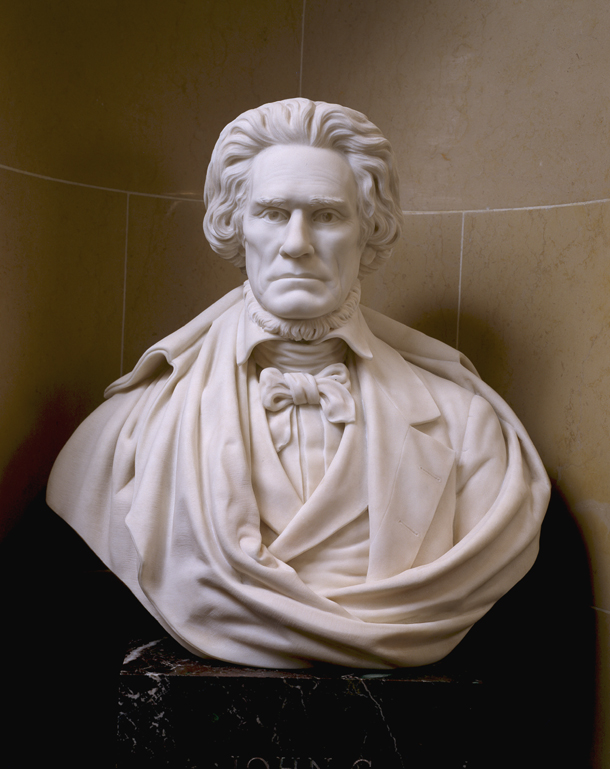Writing about the “Great Triumvirate” of Webster, Clay, and Calhoun during the third Nullification controversy in America of 1828-1832, and in particular about the Webster-Hayne debate of 1830, the late Prof. Merrill D. Peterson made this telling point: “In the course of answering Hayne point by point, Webster unfolded a [new] conception of the Union and the Constitution that stood in stark contrast to that of the South Carolinians[who were defending original intentions and the principles of republicanism and federalism].” After calling Hayne “the fanatical one” about slavery and “imagining a Northern conspiracy against slavery where none existed,” he came to the American System. “ Then “Webster again disclosed the wide gulf between two systems of politics, two philosophies of the Union.” Instead of seeing “essentially different countries with different interests [as represented by Ohio and South Carolina], we [in the North] look upon the States, not as separated, but as united . . . . We do not impose . . . geographical limits to our patriotic feelings . . . .” (Peterson, The Great Triumvirate, 176.)
When Hayne referred to the Hartford Convention and New England disunionism, Webster answered that it “was ancient history, and Webster made light work of it . . . . Of what consequence, he stated, was it in 1830 whether men or states or sections had once been Federalists or Republicans?” Webster’s dismissal of the pastwould be important to his reinterpretation of the Constitution and the Union or “his explanation of [their] true principles.” Interestingly, according to Prof. Peterson, Webster agreed with Hayne and the South Carolina Exposition & Protest. “His statement . . . . “ “Regardless, he denied the authority of a state to decide constitutional questions. ‘It is, Sir, the people’s Constitution, the people’s government, made for the people, made by the people, and answerable to the people.’ In thus stating the theory of the Constitution as the fundamental law of one people, rather than a compact of sovereign states, Webster drew upon a strain of Supreme Court interpretations, to which he had himself contributed, and upon a body of nationalist thought that included perhaps most significantly for him, Nathan Dane’s 1829 Appendix to his General Abridgment and Digest of American Law. Dane, whose claim to authorship of the Northwest Ordinance was championed by Webster, held that the Union was older than the Constitution and the states were its creatures rather than the reverse. While Webster did not go this far, he found ample basis for the nationalist theory in two provisions of the Constitution, one declaring it to be ‘the supreme law of the land,’ the other vesting in the Supreme Court the power to decide ‘all cases arising under the Constitution and laws of the United States.’ This, he said, was ‘the keystone to the arch’ of supremacy and permanence. (Peterson, The Great Triumvirate, 176-178.)
As Peterson admits, “The idea of a supreme and permanent Union was still something of a novelty in 1830. Free of the embarrassments of nullification, the Carolinians’ view of the Union as only a partnership, which might be dissolved when it became inconvenient was closer to the prevailing conception than Webster’s doctrine. Almost every politician acknowledged ‘the sovereignty of the states.’ Liberty was supposed to depend more on the rights of the states than on the powers of the general government. Even the leading textbook on the Constitution [by William Rawle] maintained the right of a state to secede peacefully, from the Union.” Ralph Waldo Emerson, Transcendentalist turned nationalist by 1850, could declare that “The Union is part of the religion of this people [as one].”(Peterson, The Great Triumvirate, 178-179.)
In his later reply to John C. Calhoun’s speech on the Force Bill, Webster “said nothing new. . . . Dropping the legalistic contract theory [the nationalists’ alternative to the compact theory], he treated the Constitution as a law of paramount obligation and as a perpetual union of one people.” In his new view, and one becoming more popular in the North as a new history for a new nation in the making, “the existence not the origins of the Constitution was the question. The founding fathers had created a national government based on the will of the people and commanding ascent to its laws.” (Peterson,The Great Triumvirate, 223.)







